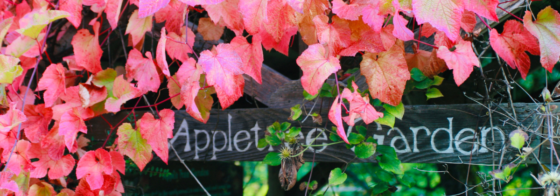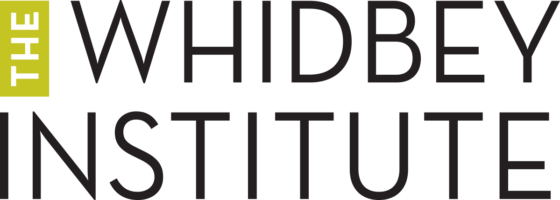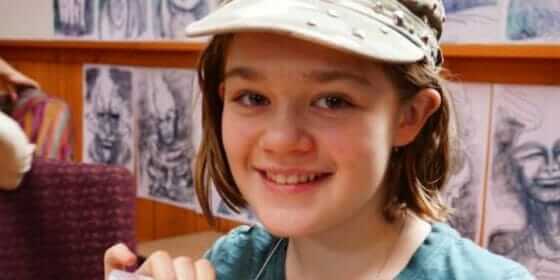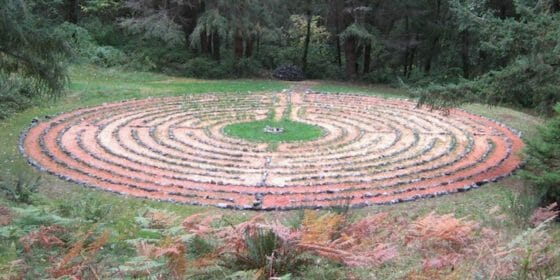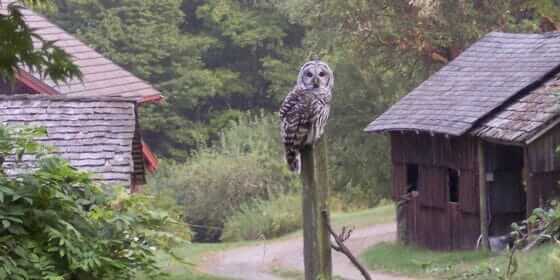The Thread of a Place
by Hannah Lee Jones
The Greek myth is familiar to a lot of us: Theseus, a warrior from Athens, sets out to kill the Minotaur, a half-bull and half-human monster who lives inside a labyrinth on Crete. The labyrinth is so intricate that no mortal has found their way out. But Theseus falls in love with Ariadne, who gives him a thread to unravel so that he’s able to enter the labyrinth, kill the Minotaur, and make his way home.
The story’s longevity owes something to its allegory for our lives. I know this because I’ve also been in one – at Chinook, though instead of a Minotaur at its center, this one’s bulls-eyed with coins and tree cones. On a misty day three winters ago, as part of a year-long non-Institute program called Seasons of the Soul, I found myself walking the seemingly endless distance to the center, then retracing my steps all the way back to its opening, as I told the story of my life.
I did this while two women witnessed me from the bench on the labyrinth’s northern edge.
This sounds hard because it was, especially for me. As a former employee of the Whidbey Institute I’d walked the labyrinth many times, but the idea of being seen as I recounted the twisty and often sordid details of my past and present, in a loud voice that rang through that clearing in the woods, terrified me. Yet as I walked deeper into the labyrinth, the words spooling themselves out in tales of childhood wounds, of betrayals inflicted and suffered, of changes made or brought upon my life without warning, questions flooded my mind: what I was speaking, was it true? To what center was I moving? What personal monsters resided there? What did I wish to make of my short time on earth?
The labyrinth never helped to answer these questions, much as I wished it would. Instead, it deepened them, giving me a handhold, perhaps a thread like Ariadne’s, to anchor my path forward – the duration of which was not the ten or so minutes it took me to walk the thing, but my entire life.
So that when I finished my story and stood again at the mouth of the labyrinth, hearing the women murmur their support and admiration, my heart hammering like I’d just run a marathon, the insight came over me: courage is required for a journey like this, because it’s one you take alone. No one can go with you. But this insight was accompanied by an even more powerful one: your journey isn’t complete without others to support and witness you.
The land and Institute have played the role of support and witness in my life for a long time now. Since I took that long and very personal walk to the labyrinth’s center, I’m occasionally reminded of the insights I had, in the shape of even more questions: “Remember this place? How’s your journey going? Remember how this place held you and your friends as you supported each other?”
I received one such reminder the afternoon I came to the land to wish Maggie Mahle farewell, as she departed last November from her role as the Institute’s Land Care Coordinator. As we stood talking by the Labyrinth, suddenly a single, triangle-shaped frond of wood fern on the north slope began waving at us.
Or maybe at me? There was no wind, so it’s like the fern frond was waving itself, behind the very spot where the women had sat, witnessing me as I walked the labyrinth two years earlier.
“Check that out,” Maggie said, mimicking the fern’s motion with her hand. “It’s like it’s trying to get your attention, saying HEY!”
Hey, indeed. Hey to the magic of mazes and questions to which there are no firm answers, to living aloud the truth of one’s life; to the courage required by the journey that we must take alone, yet not alone.
Standing with Maggie by the labyrinth, I pictured two beautiful Ariadnes sitting on that bench, listening to what I had to share as if it was the most important and beautiful thing in the world.
March 10, 2015

